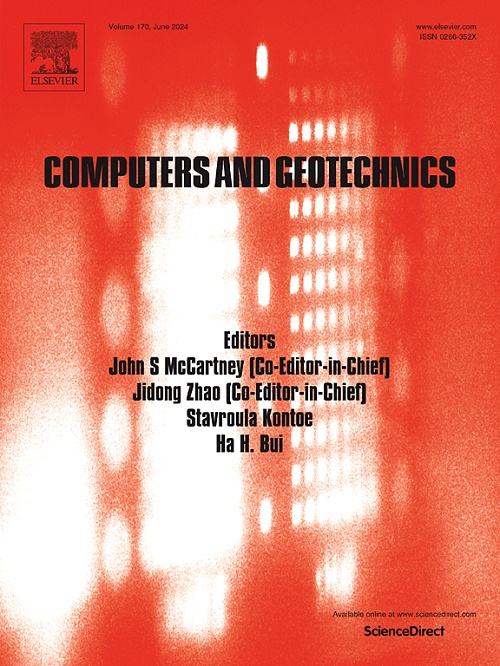Microscopic insights into local scour around a vertical circular pile under steady current: Coupled LES-CGDEM simulations
IF 5.3
1区 工程技术
Q1 COMPUTER SCIENCE, INTERDISCIPLINARY APPLICATIONS
引用次数: 0
Abstract
Local scour around pile reduces its bearing capacity, jeopardizing the superstructure safety. Previous studies on this have primarily been based on continuum mechanics. Given that the scour process involves interactions between fluid-particle and particle–particle, the methods based on the continuum mechanics struggle to adequately account for collision effects between particles, while also failing to capture the migration process of soil particles. This study employs the coupled large eddy simulation (LES) and coarse-grained discrete element method (CGDEM) to conduct a detailed simulation of the local scour evolution around a vertical circular pile under unidirectional steady flow from a microscopic perspective, in which three flow intensities are considered in the simulation. It is found that as the flow intensity increases, the difference in scour depth upstream and downstream of the pile diminishes. Initially, the scour upstream of the pile is jointly controlled by scouring at the pile toe and soil erosion on the top slope surface, while it is dominated by pile toe scour in the later stage. The pile toe scour is associated with the multiple horseshoe vortices (HVs) upstream of the pile; the “NASA wall-mounted hump” downstream of the pile restricts further migration of the deposited sediment; an “unstable particles cluster” is formed on the sides of the pile, creating a preferential scour path. Particles upstream of the pile undergo a sequence of slow motion upstream, complex flow around the pile, accelerated movement downstream, and deposition, while particles on the sides of the pile experience slowly settling, accelerated motion, and deposition. The work further deepens the understanding of scour evolution mechanism.
对稳定水流下垂直圆桩周围局部冲刷的微观观察:LES-CGDEM 耦合模拟
桩周围的局部冲刷会降低其承载能力,从而危及上部结构的安全。以往对此的研究主要基于连续介质力学。鉴于冲刷过程涉及流体-颗粒和颗粒-颗粒之间的相互作用,基于连续介质力学的方法难以充分考虑颗粒之间的碰撞效应,同时也无法捕捉土颗粒的迁移过程。本研究采用大涡度模拟(LES)和粗粒度离散元法(CGDEM)耦合方法,从微观角度对单向稳定流作用下垂直圆桩周围的局部冲刷演变过程进行了详细模拟,模拟中考虑了三种流强。结果发现,随着水流强度的增加,桩体上下游的冲刷深度差逐渐减小。初期,桩上游的冲刷由桩趾冲刷和坡顶表面的土壤侵蚀共同控制,而后期则以桩趾冲刷为主。桩趾冲刷与桩上游的多个马蹄形漩涡(HVs)有关;桩下游的 "NASA 壁挂驼峰 "限制了沉积泥沙的进一步迁移;桩侧形成了 "不稳定颗粒群",形成了优先冲刷路径。堆积体上游的颗粒经历了缓慢向上游运动、绕堆积体复杂流动、加速向下游运动和沉积的过程,而堆积体两侧的颗粒则经历了缓慢沉降、加速运动和沉积的过程。这项工作进一步加深了人们对冲刷演变机理的理解。
本文章由计算机程序翻译,如有差异,请以英文原文为准。
求助全文
约1分钟内获得全文
求助全文
来源期刊

Computers and Geotechnics
地学-地球科学综合
CiteScore
9.10
自引率
15.10%
发文量
438
审稿时长
45 days
期刊介绍:
The use of computers is firmly established in geotechnical engineering and continues to grow rapidly in both engineering practice and academe. The development of advanced numerical techniques and constitutive modeling, in conjunction with rapid developments in computer hardware, enables problems to be tackled that were unthinkable even a few years ago. Computers and Geotechnics provides an up-to-date reference for engineers and researchers engaged in computer aided analysis and research in geotechnical engineering. The journal is intended for an expeditious dissemination of advanced computer applications across a broad range of geotechnical topics. Contributions on advances in numerical algorithms, computer implementation of new constitutive models and probabilistic methods are especially encouraged.
 求助内容:
求助内容: 应助结果提醒方式:
应助结果提醒方式:


